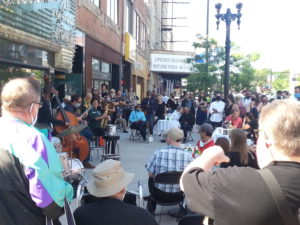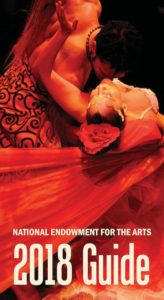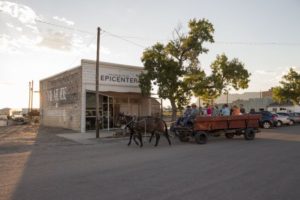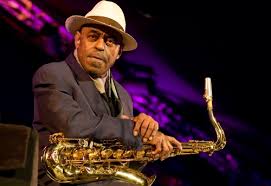In early March – only four months ago – I flew between two of the largest U.S. airports, O’Hare and JFK, to visit New York City. I stayed in an East Village apt. with my daughter and a nephew crashing on her couch. We ate barbecue at a well-attended Jazz Standard performance by drummer Dafnis […]
Jazz and beyond projects with 2018 NEA funding support
Given all the noise, the National Endowment for the Arts’ $25 mil for arts, literature and education announced Feb. 7 may have been overlooked. But these funds and the projects they support, nationwide, should be noted. From more than $3 million going to initiatives strictly labeled “Music” (exclusive of “Musical Theater” or “Opera”) here’s my subjective selection of […]
NEA supports jazz and US arts nationwide
The National Endowment of the Arts, arguably the most misunderstood and beleaguered doing-good office of the federal gov’t (excluding the NEH, EPA, Consumer Financial Bureau, Civil Rights Division of the Justice Dept., and a few others) has issued its 2017 funding report, highlighting that its monies (monies from we US taxpayers) flow to communities in all […]
NEA doubles down on beyond-jazz with 2016 Jazz Masters
The National Endowment of the Arts has doubled down on celebrating jazz beyond “jazz” — music that has exploded historic parameters or preconceptions of  “jazz” conventions — by naming as 2016 Jazz Masters the saxophonists Pharoah Sanders and Archie Shepp — both protégés of the late, great John Coltrane — and Gary Burton, an innovator of technique and content who’s embraced pop, […]
New NEA Jazz Masters: A classy last class
The National Endowment for the Arts’s final designated Jazz Masters are all worthy: drummer Jack DeJohnette, saxophonist Von Freeman, bassist Charlie Haden, singer Sheila Jordan and trumpeter-educator-organizer-gadfly Jimmy Owens have had long and profoundly influential if not broadly celebrated or financially rewarded creative careers. So much the worse that this 30 year program highlighting genuine American artistic […]
President Obama digs Sonny Rollins
President Barack Obama paid beautiful lip service to great American artists and arts yesterday, conferring the 2010 National Medal of Arts and Humanities on heroes including Sonny Rollins, age 80. “I speak personally here,” said the president at 3 minutes, 30 seconds into his address, alluding to authors, poets, historians, “because there are people here […]
NEA wants to end Jazz Masters program
The National Endowment of the Arts’ FY-12 Appropriations Request has just been posted, and cuts $21 million to return to its 2008 funding level. Among program “modifications”: the establishment of “American Artists of the Year awards,” which will “remove specific reference to Jazz, Folk, and Opera” and give discipline awards annually in two categories: Performing […]
NEA Jazz Masters concert on ustream, NEA gives 1/4 mil for gigs
Last night’s NEA Jazz Masters concert at Jazz at Lincoln Center was ustreamed — for the first time allowing the world to see live, free and forever America’s official ceremony knighting the duly experienced, accomplished and original wise-people who create and perpetuate America’s living vernacular music.  It was great to actually be there, too – amid a […]
Twitter campaign #jazzlives after one year
#Jazzlives — the Twitter campaign aimed at demonstrating that there is a big and enthusiastic audience for live jazz — is one year old. What has it wrought? First: What is #jazzlives and how does it work? To participate in the campaign, audience members at live jazz performances “tweet” – write a post on their […]
Jazz journalism & beyond weekend
Jazz journalists conferenced in New York City last weekend as arts presenters, National Endowment for the Arts Jazz Masters and musical showcases galore (including an audience-happy Winter Jazzfest and the debut of drummer Jack DeJohnette‘s hot new band) justified the very existence of the profession.
Mr. Teachout gets the word: Jazz’s Swing Era popularity past
Biographer of H L. Mencken and (coming soon) Louis Armstrong, ArtsJournal blogger and scribe for the Wall Street Journal Terry Teachout has raised a fuss by pointing to the National Endowment for the Arts‘ study citing declines in jazz audiences from 2002 to 2008 (and indeed from 1982 to 2008). That this data was released in June […]
Hurray for the new NEA Jazz Masters
Dean of post-jazz Muhal Richard Abrams,  doyenne of vocalese Annie Ross and George Avakian, who invented jazz albums and reissues, popularized the LP and live recording, are among eight 2010 Jazz Masters named today by the National Endowment of the Arts. New York-based pianists Kenny Barron and Cedar Walton, exploratory reedist Yusef Lateef, big band composer-arranger […]
Recent NEA grants-getters win again in Arts Recovery act
The National Endowment of the Arts’ first program of the Obama “Recovery Act” focuses on the preservation of jobs in the arts. But it upholds an adage quoted by Billie Holiday in “God Bless the Child“: “Them that’s got shall get.” Applicants must be organizations that have received NEA grants during the immediately prior four years (since […]




